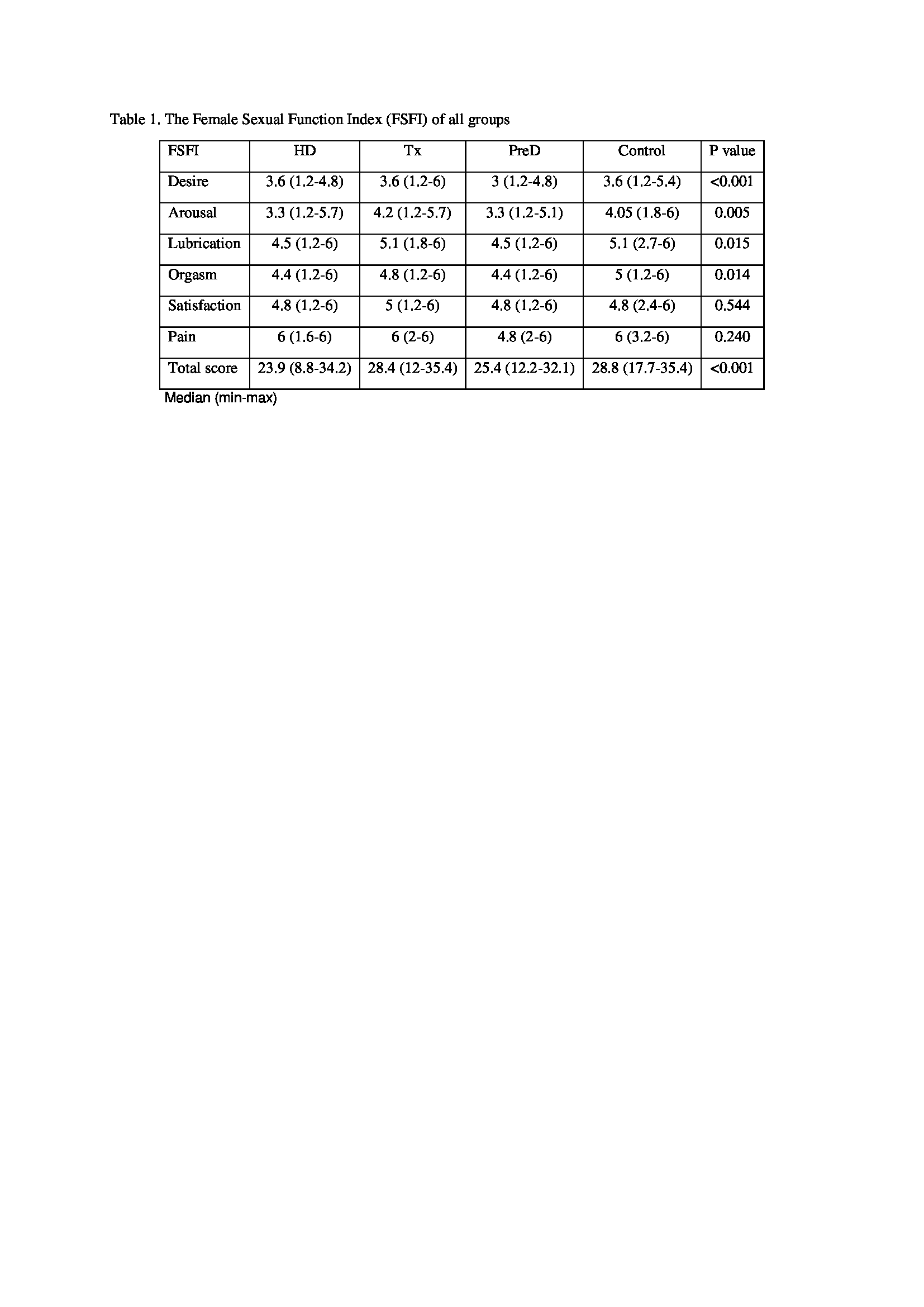Sexual Dysfunction and Risk Factors in Females Patients on Renal Replacement Therapy
Nihal Yılmaz 1, Alparslan Ersoy1, Abdulmecit Yıldız1, Aysegul Oruc1, Yavuz Ayar1, Canan Ersoy2.
1Department of Nephrology, Uludağ University Medical School, Bursa, Turkey; 2Department of Endocrinology and Metabolism, Uludağ University Medical School, Bursa, Turkey
Introduction: Women with chronic kidney disease have a higher risk of sexual dysfunction (SD). The etiology is often multifactorial and may include psychological problems. A successful kidney transplantation can improve SD. This study aimed to investigate SD frequency, and risk factors in the females under renal replacement therapy (RRT) and in the healthy ones.
Materials and Methods: A total of 62 kidney transplant recipients (Tx), 43 hemodialysis (HD) and 35 predialysis (PreD) patients and 52 healthy females were included. Sociodemographic and risk factor survey forms, the hospital anxiety depression scale and the 36-Item Short Form Health Survey were used. Sexual function was assessed according to the Female Sexual Function Index (FSFI). Women with a score ≤22.7 were classified as presenting sexual dysfunction.
Results: Control and Tx patients groups were significantly younger than HD and PreD patients. There were differences in the ratios of asthenia and fatigue, pelvic surgery, urinary incontinence, cystitis history, dyspareunia, smoking, use of antidepressant and beta blockers between the groups. The depression and anxiety ratios of the groups were similar. The physiological health scores of the control group were significantly higher than those of the PreD and Tx groups and also scores of the Tx group than those of the HD and PreD groups. Mental health scores of the control group were significantly higher than those of the PreD and HD groups.
The SD ratio of Tx group with FSFI (n:10, 16.1%) was significantly lower than HD group (n:18, 41.9%, p=0.006). The SD ratio of PreD group was 31.4% (n:11). The SD ratio of control group was 23.1% (n:12). Desire scores of the Tx and control groups were higher than those of HD and PreD groups. Arousal scores of HD and PreD group were significantly lower than those of control (p=0.013 vs. HD, p=0.047 vs. PreD) and Tx (p=0.004 vs. HD, p=0.015 vs. PreD) groups. Lubrication score of HD group was lower than those of Tx (p=0.006) and control (p=0.014) groups. Orgasm score of HD group was lower than those of Tx (p=0.012) and control (p=0.009) groups, and PreD group score was lower than that of control group (p=0.046). The overall scores of the HD and PreD groups were significantly lower than those of Tx (p=0.001 vs. HD, p=0.002 vs. PreD) and control (p=0.003 vs. HD, p=0.005 vs. PreD) groups (Table 1). Logistic regression analysis showed that inadequate sexual information (OR:3.333, 95%CI: 1.426-7.790, p=0.005), presence of anxiety (OR:2.978, 95%CI: 1.093-8.117, p=0.033) and depression (OR:4.514, 95%CI: 1.676-12.156, p=0.003) increased SD risk. Kidney transplantation significantly reduced SD risk (OR:0.236, 95%CI: 0.073-0.766, p=0.016).
Conclusion: SD improve after successful transplant. Our results do not support the impact of the sociocultural and economic factors in sexual function of women on renal replacement treatment. However, psychological factors negatively affect sexual function in dialysis patients. 
